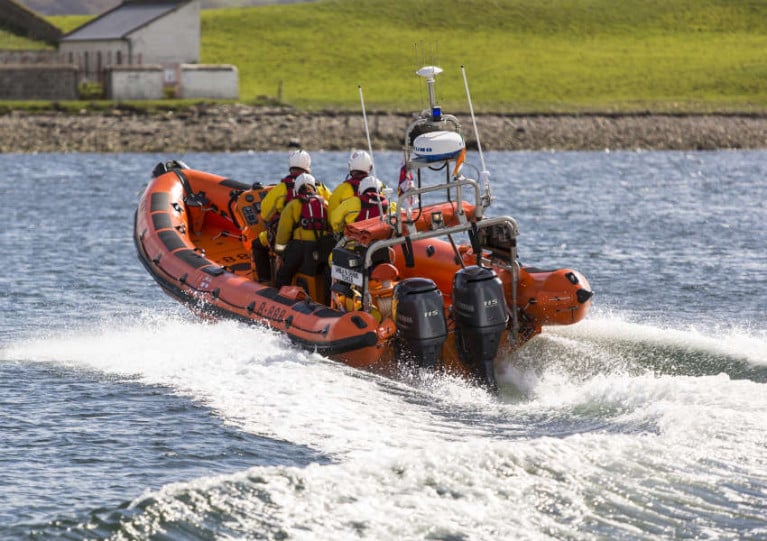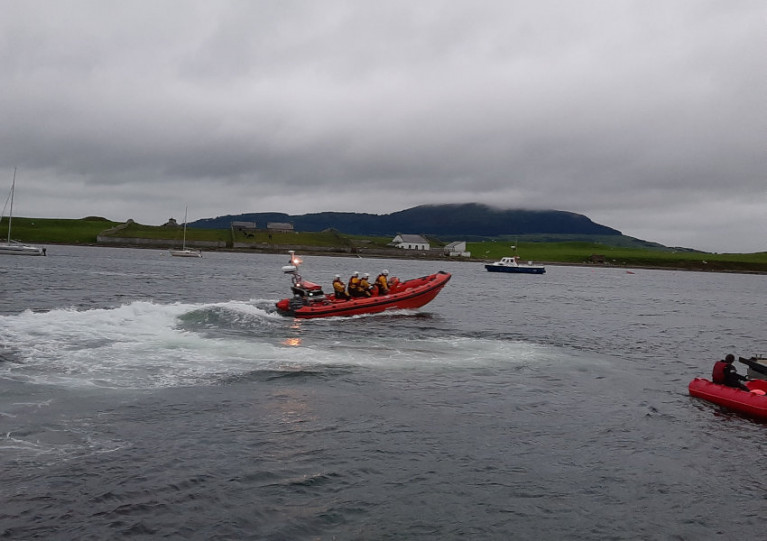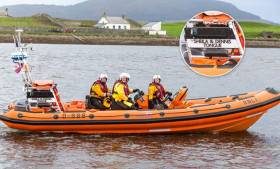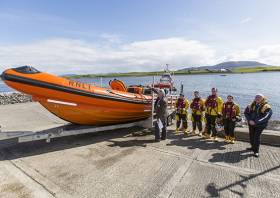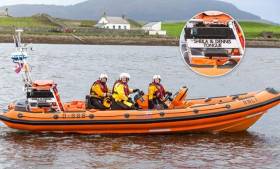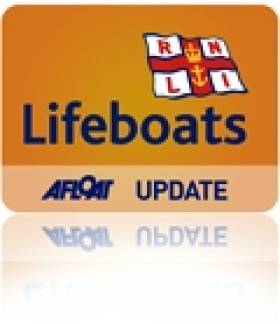Displaying items by tag: Sligo Bay
Sligo Bay Lifeboats Assists in Rescue of Injured Fisherman
Sligo Bay RNLI launched to the aid of a fisherman who sustained an injury onboard a boat off Inishmurray at the weekend.
The volunteer crew were requested to launch their inshore lifeboat shortly before noon on Sunday (5 September) following a report that a person onboard a charter fishing vessel had sustained an injury off the island some 15km from the lifeboat station.
The casualty was part of a group enjoying a fishing trip when the accident occurred. The skipper acted promptly dialling 999 for help and both Sligo Bay RNLI’s lifeboat and the Irish Coast Guard helicopter Rescue 118 from Sligo were requested to the scene.
Weather conditions at the time were described as having light winds, good visibility and flat seas.
On arrival, the lifeboat crew found the coastguard already on scene and administrating casualty care.
One of the lifeboat crew, Owen McLoughlin, went aboard the fishing vessel to assist the winch operator with the evacuation of the casualty and to manage the highline from the helicopter.
The casualty was then safely transferred by helicopter to Sligo University Hospital for treatment.
Speaking following the callout, Sligo Bay RNLI crew member Owen McLoughlin said: “We would like to wish the casualty a speedy recovery.
“Our volunteers regularly train with our colleagues in the Irish Coast Guard for all types of scenarios at sea and this call out was a good example of how beneficial that training and inter-agency cooperation is.”
Sligo Bay Lifeboat Crew Rescue Swimmers Off Rosses Point
Sligo Bay RNLI’s volunteers were called to the rescue of four swimmers in difficulty off Rosses Point yesterday afternoon, Sunday 22 November.
The four women, who were all seasoned swimmers, were caught in a swell when trying to get back ashore.
A number of onlookers on the beach called for the emergency services and both Sligo Bay RNLI’s lifeboat and the Irish Coast Guard’s Sligo-based helicopter Rescue 118 were dispatched to the scene.
One of the four swimmers managed to get ashore unaided in the meantime, while one other was rescued by the volunteer lifeboat crew who administered casualty care en route to the lifeboat station where she was passed into the care of an ambulance crew.
The other two casualties were airlifted to safety by the crew of Rescue 118. All four swimmers were taken to Sligo General Hospital for assessment, as Sligo Bay RNLI reports.
Aisling Gillen, Sligo Bay RNLI’s volunteer lifeboat press officer, said: “We received a lovely message from one of the swimmers last night to thank us for saving their lives which was very kind and we would like to wish them all well.
“Seasoned open water swimmers have a great deal of experience and do observe proper safety precautions. However, the dangers this time of the year far outweigh the challenges that apply in summer. Cold water and currents can tire a swimmer quickly and make it harder to return to shore.”
One hour after this incident, the Sligo Bay lifeboat crew received a second call — this time to a surfer in difficulty at Strandhill, but who was able to make his own way ashore as the lifeboat stood by.
Sligo Bay Lifeboat Launches To Lone Surfer Ahead Of Storm Ellen
Sligo Bay RNLI volunteers launched last night just hours before the arrival of Storm Ellen to reports of a lone surfer heading out to sea in the fading light.
The inshore lifeboat was joined by the Sligo-based Irish Coast Guard helicopter Rescue 118 as it headed to Strandhill just after 8.30pm yesterday evening, Wednesday 19 August.
Freshening south-easterly winds were blowing 14 knots ahead of the storm’s track north from the West Cork coast.
Once at the scene, the lifeboat crew located the surfer who was able to make their own way ashore.
Speaking following the callout, Aisling Gillen of Sligo Bay RNLI said: “Thankfully this was a happy ending. We would remind everyone of the importance of paying heed to safety warnings during periods of stormy weather and exercise extreme caution.
“Stay back, stay high and stay dry.”
Sligo Bay RNLI was involved in the rescue of a swimmer in difficulty at Rosses Point earlier this week.
The volunteer lifeboat crew launched their inshore lifeboat at 8pm on Wednesday evening (15 July) to go to the aid of the open water swimmer, who was in the water off the first beach in Rosses Point.
On arrival at the scene, the crew observed that the swimmer was being helped by other swimmers and kayakers who were nearby at the time.
The swimmer was then taken aboard the lifeboat and brought back to station where they were transferred into the care of a waiting ambulance and brought to Sligo University Hospital for further treatment.
Speaking after the callout, Sligo Bay RNLI press officer Aisling Gillen said: 'We would like to wish the swimmer a speedy recovery and commend everyone involved in the rescue as the sea conditions at the time were very choppy and this could have had a very different outcome.
“As the summer continues, we would remind everyone to always respect the water.
“Always check weather and tide times before you go, if swimming, never swim alone, and should you get into difficulty or see someone else in trouble, dial 999 or 112 and ask for the coastguard.”
Divers Rescued Off Sligo In Heavy Seas
#Rescue - The Irish Times reports on the rescue of eight divers off the Sligo coast after a boat capsized this morning (Sunday 19 March).
Sligo Bay RNLI were tasked to the scene off Aughris Pier in Sligo town after the incident during a diving excursion, rescuing seven from a heavy swell.
An eighth person was subsequently recovered from the water and airlifted to Sligo Hospital by the Irish Coast Guard helicopter Rescue 118, which was diverted from the ongoing search for the missing crew of Rescue 116.
Independent.ie reports that the latter diver was in serious condition, and that a second diver was later hospitalised.
Sligo Bay RNLI’s New Inshore Atlantic 85 Lifeboat Named
At a special ceremony held today Sligo Bay RNLI officially named its new Atlantic 85 lifeboat, Sheila & Dennis Tongue, at its station in Rosses Point.
Peter Killen, a member of the Irish Council of the RNLI, accepted the lifeboat on behalf of the RNLI before handing her over into the care of Sligo Bay Lifeboat Station.
He paid tribute to the donors Sheila & Dennis Tongue who had left a generous legacy to the RNLI in recognition of the vital life-saving work of the charity and as a thank-you for the happy days they spent living on the coast at Exmouth.
The couple were born in Birmingham in the 1920s and on Dennis’s retirement they moved to Devon where they lived until their eighties, overlooking the coast. The couple did not have any children and it was during their retirement that they came to know and admire the work of the RNLI and recognise its place in the life of the communities it served.
The couple were represented today by their nephews Raymond and Philip Tongue who travelled to Ireland for the special occasion.
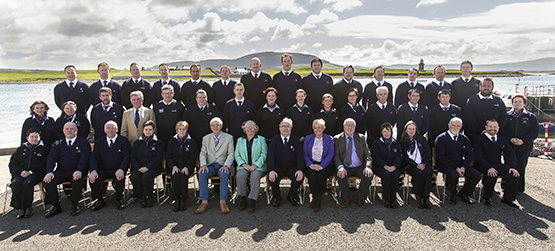
Philip had the honour of officially naming the lifeboat during the ceremony which was also attended by the donor family of Elsinore, Sligo Bay’s former lifeboat which during her 13 years on service launched 189 times and brought 155 people to safety.
The new state of the art Atlantic 85 lifeboat was introduced into the RNLI fleet in 2005. The lifeboat is 8.4 metres in length and weighs 1.8 tonnes. Improvements on its predecessor include a faster top speed of 35 knots, radar, provision for a fourth crew member and more space for survivors.
Since the new lifeboat went on service on Sligo Bay in November it has launched four times to call outs.
During the event, Willie Murphy, Sligo Bay RNLI Lifeboat Operations Manager said the naming ceremony and service of dedication was a wonderful occasion in the history of the lifeboat station, and marked the tremendous generosity of Sheila and Dennis Tongue.
‘It is wonderful to have the opportunity to thank the family directly for this amazing generosity. We assure you that you will always have a warm welcome here among us and we genuinely hope you will come and visit. We also commit to you our utmost dedication in ensuring that this wonderful new lifeboat is indeed a lifesaver in Sligo Bay.’
Mr Murphy paid tribute to the volunteers at Sligo Bay RNLI saying it was they who would give the new boat life: ‘It is your commitment and courage that will save lives with her in the future. Being a volunteer, whether on shore or afloat, involves a huge commitment in time and energy and I want to thank you and pay tribute to your dedication. Most importantly I wish all of you who put to sea safe passage aboard the Sheila and Dennis Tongue.’
He thanked the local fundraising branch for their untiring work and praised the generosity of the people of Sligo and further afield for helping to raise funds to enable the station to continue to save lives at sea.
He also thanked the families and friends of the crew, acknowledging that having someone involved in the RNLI was often not easy:
‘Away off for the many training sessions, or when the pagers go off you are being abandoned at the check-out in the supermarket, following down to the station with clothes as they ran off in their pyjamas, or suddenly having to make a whole new set of arrangements for the day. This can be a right pain, It’s not often we get a chance to publicly thank you, but we do today, to each and every one of you for your support.’
A lifeboat station was established at Sligo Bay in 1998. Situated at Rosses Point it is flanked by stations at Ballyglass to the south and Bundoran to the north.
In 1998, a D class lifeboat was sent to the station for evaluation and in 1999 an Atlantic 21 class lifeboat B-525 Spix’s Macaw was placed on temporary station duty on 12 March.
An Atlantic 21 class lifeboat B-512 US Navy League was placed on station on the 26 October.
On the 2 February 2002, B-781 Elsinore, an Atlantic 75 class, was put on service.
The new lifeboat, an Atlantic 85 and the latest version of the B class, was placed on service on the 19 November last year.
A crowd of well-wishers turned up to see the lifeboat officially named today with a bottle of champagne poured over the side of the boat before it launched at the end of the ceremony.
Among the guests officiating at the ceremony were Martin Reilly, Chair of the Lifeboat Management Group who welcomed guests and opened proceedings; Raymond Tongue, nephew and representative of the donor, who handed the lifeboat over to the RNLI, Peter Killen, Member of the RNLI Council for Ireland, who accepted the lifeboat on behalf of the RNLI and handed her into the care of the lifeboat station and Willie Murphy, Sligo Bay RNLI Lifeboat Operations Manager, who accepted the lifeboat on behalf of the station.
The Rt Reverend Monsignor Gerard Dolan PP, and the Very Reverend Arfon Williams, led the Service of Dedication
#RNLI - The new Sligo Bay RNLI Atlantic 85 lifeboat is to be officially named Sheila & Dennis Tongue during a ceremony at the lifeboat station at Rosses Point in Sligo next Saturday 16 April 2016 at 3pm.
The lifeboat will be passed into the care of the RNLI and officially named during a short ceremony and service of dedication by brothers Raymond and Philip Tongue, who are nephews of the couple and will travel to Ireland with their families for the special event.
Mr and Mrs Dennis Tongue left a generous legacy to the RNLI in recognition of the vital life-saving work of the charity and as a thank-you for the happy days they spent living on the coast at Exmouth.
The couple were born in Birmingham in the 1920s and on Dennis’s retirement they moved to Devon where they lived until their eighties, overlooking the coast.
The couple did not have any children and it was during their retirement that they came to know and admire the work of the RNLI and recognise its place in the life of the communities it served.
The new lifeboat that arrived in Sligo last November, as previously reported on Afloat.ie, replaces Elsinore, which during its 13 years on service launched 189 times and rescued 155 people.
Sligo Bay RNLI lifeboat operations manager Willie Murphy, who will be accepting the lifeboat into the care of the station from the Tongue family on behalf of the volunteers, said: "I would like to express our sincere gratitude to the late Mr and Mrs Tongue for their generous and life-saving gift.
"This lifeboat is the vessel that will carry our volunteer lifeboat crew out to sea to save lives and rescue people in difficulty and it will provide our volunteer lifeboat crew the opportunity to train and develop their skills to carry out that work.
"We look forward to welcoming the family of Sheila and Dennis to this beautiful part of the world and we hope this is the beginning of a wonderful friendship with them."
The Atlantic 85 lifeboat was built at a cost of €276,000 and was introduced into the RNLI fleet in 2005. It operates mostly in shallow waters close to the shore or cliffs, among rocks and caves. It is operational in conditions up to a Force 7 and the design accommodates four crew and multiple casualties.
The lifeboat has a top speed of 35 knots and has a manually operated righting mechanism with inversion proofed engines, meaning it can be righted after capsize and kept operational.
The boat is also capable of being beached in an emergency without sustaining damage to the engines. It carries a full suite of communication and electronic navigation aids.
Sligo Bay RNLI crew and management will put their new lifeboat on display to the general public on their station open day on Sunday 19 June.
Dromard Coastguard Station Is Back On The Market
#WaterfrontProperty - The Old Coastguard Station in Dromard, Co Sligo is back on the market for anyone interested in owning a piece of Ireland's maritime heritage..
The historic five-bedroom property on seven acres with some 1,000ft of sea frontage and spectacular views over Sligo Bay "would make an ideal home for both busy and creative people" says agent Ganly Walters, which is seeking €1.8 million - down from the €2.175 million asking price in the summer of 2014.
Independent.ie has more on the history of the building, which dates from 1873 but was recently completely refurbished internally though retains its Gothic windows and entranceway, as well as the old station watchtower that now serves as a utility room, and a stone boathouse and slipway with boat moorings.
Children Rescued In Surprise Sligo Bay Swell
#Rescue - RTÉ News reports that a large group of children in a sailing course were rescued today (Monday 12 August) when their boats were caught in a surprise swell in Sligo Bay.
The 17-strong group of children ages 9 to 12 and their instructors from Sligo Yacht Club were divided between five small sailing dinghies when the sea suddenly turned rough, capsizing two of the boats.
But the instructors acted swiftly in calling for help, with the Sligo Bay RNLI lifeboat arriving on scene quickly to rescue those who had not already made it to shore.
RTÉ News has more on the story HERE.
Sligo Bay RNLI Celebrates 15th Anniversary This Weekend
#RNLI - Sligo Bay RNLI will celebrate its 15th anniversary this Sunday (16 June) with an open day at the lifeboat station in Rosses Point.
There will be an opportunity to chat to the crew, have a look around the station, visit the lifeboat shop and enjoy the seafaring music provided by the groups involved in the Sea Shanty Festival which is also taking place this weekend from 14-16 June.
Sligo Bay RNLI began life in a prefab cabin at Sligo Yacht Club back in 1998. Construction on the new lifeboat station situated at the pier in Rosses Point was completed in 2002. It houses a D Class lifeboat named Elsinore and has 22 volunteer crew members, along with a fundraising team and a lifeboat shop.
As part of the Sea Shanty Festival there will a gala concert in the Yeats Country Hotel on Saturday night (15 June), all proceeds from which will go the Sligo Bay lifeboat station. Tickets are available from the lifeboat station shop, Bay View Stores, Rosses Point and Source on John St in Sligo.
Elsewhere, RNLI volunteers and supporters from around Ireland were recognised for their role in supporting and raising funds and awareness for the lifesaving charity and its crews at the RNLI Annual Presentation of Awards in the Great Hall at Trinity College Dublin.
Guest of honour was the outgoing chairman of the RNLI, Admiral the Lord Boyce, who handed out awards to 51 volunteers throughout Ireland.
Irish Coast Guard director Chris Reynolds and his wife Geraldine along with Irish Water Safety CEO John Leech were also in attendance at the ceremony, presided over by the chairman of the RNLI Council of Ireland, John Coyle.
Awards presented on the day included two Gold Badges, four Silver Badges, 19 statuettes, 17 Bronze Badges, one pair of RNLI binoculars and eight Supporter Awards.
The Gold Badges were received by Jackie O’Grady from Clifden RNLI branch for his work over 25 years with the station, and to Hugh Stafford in Wexford for his role in the setting up of the Fethard-on-Sea lifeboat station in the early 1990s and his work since then in raising funds for the charity.
Also receiving an RNLI statuette was former lifeboat man at Rosslare Harbour, Fergus Wickham, who was recognised for almost five decades of volunteering with the RNLI, first as a lifeboat man and then as a launching authority at the station.


























